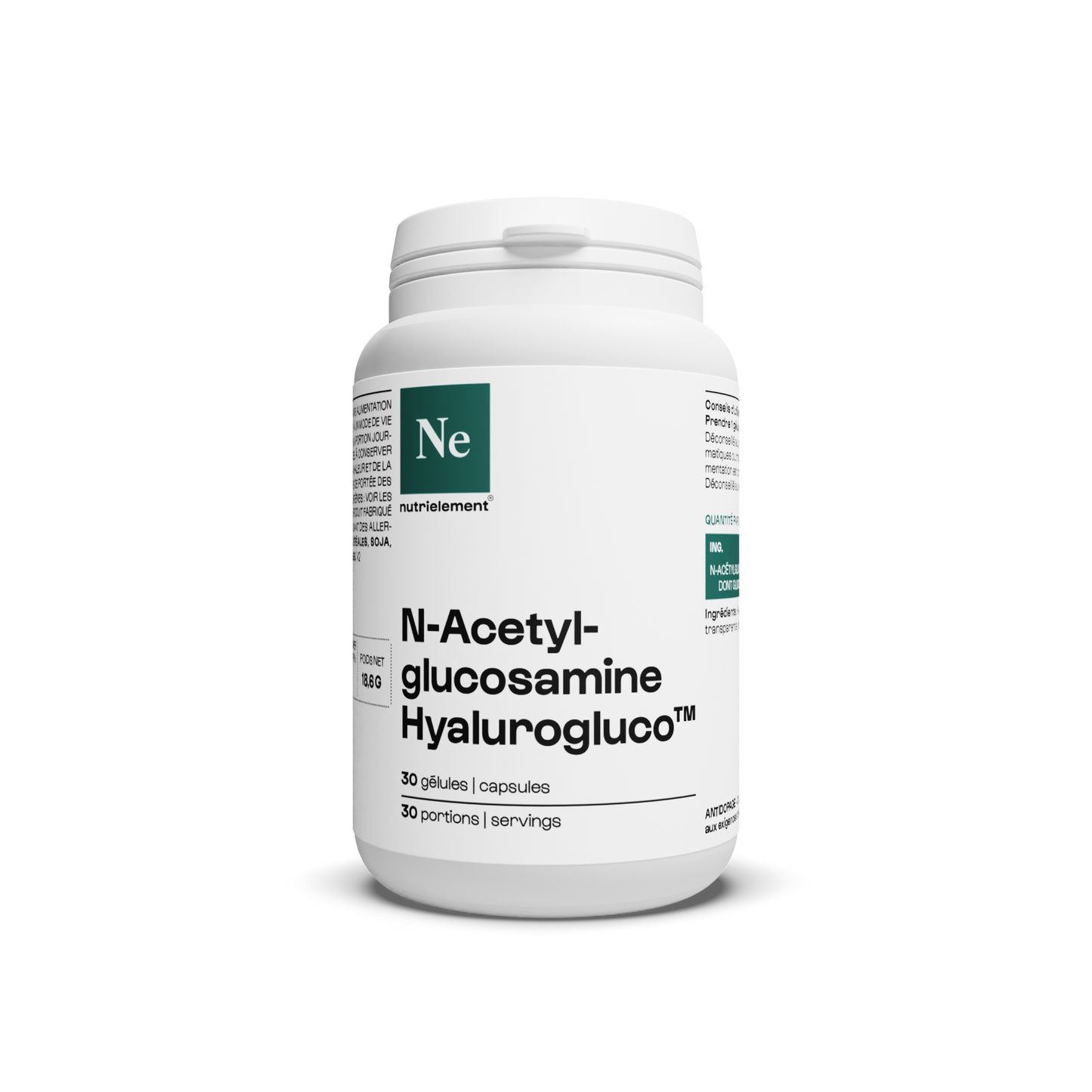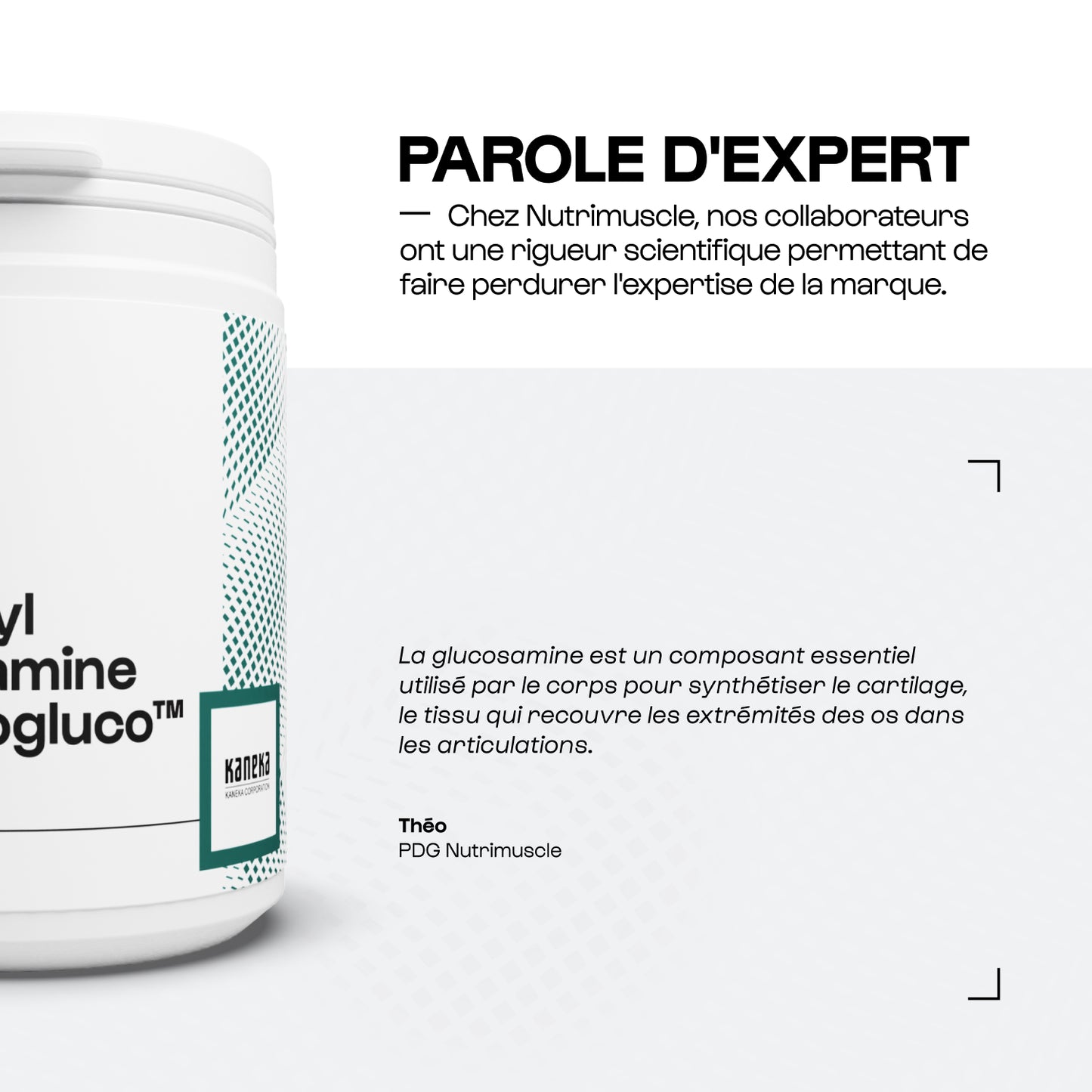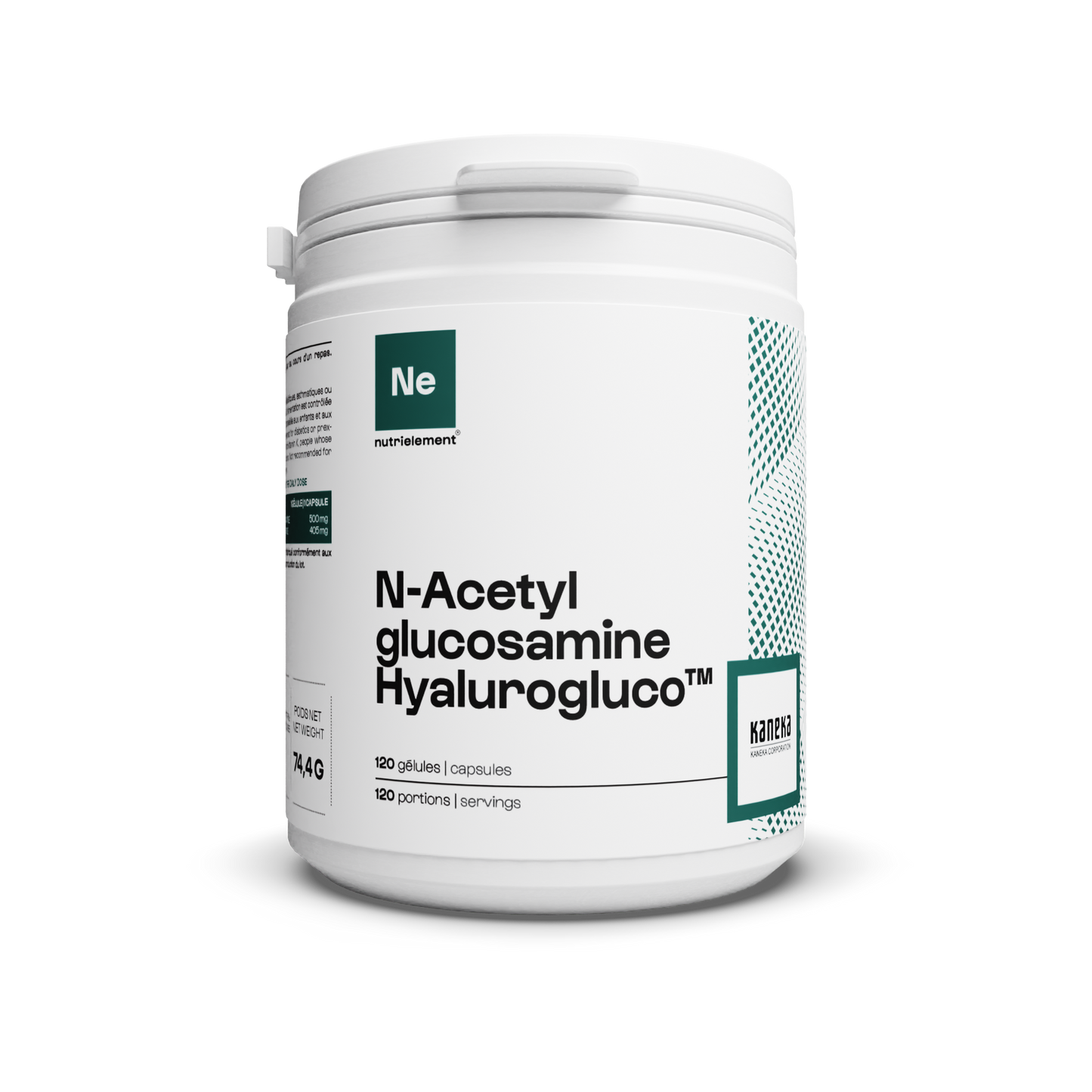| N-Acétylglucosamine dont glucosamine | 500mg 405mg |
|---|
Retour sur la boutique
Votre panier est vide
Des avantages exclusifs avec le NM Club
Retour sur la boutique
Votre panier est vide
Code promo et parrainage appliqués à l'étape suivante
Livraison à domicile offerte à partir de 110€ d'achats
Livraison à domicile gratuite à partir de 110€ d'achats
Transparence & traçabilité


Nous vous ferons parvenir un e-mail pour réinitialiser votre mot de passe

Jusqu'à -20%







Le composant naturel des articulations.
Jusqu’à -20% sur une sélection de compléments !
*La réduction se fait automatiquement lors de l'ajout au panier.
Hors formats 4 kg et +, formats 800 gélules et +, gamme textiles et accessoires, protéines contenant de la Whey Native, Clear Whey, Créatine, Musclepump et Pré-workout 2kg.
En stock | DLUO : 30/01/2027
+ 19 points de fidélité.
Paiement en 3 fois sans intérêt

Livraison gratuite en point relais dès 50€ d'achat.

Transparence & Traçabilité
Glucosamine (N-Acetylglucosamine) Hyalurogluco™ en gélules







Maintien de la mobilité, flexibilité et solidité des articulations, os et tendons pour prévenir les blessures et assurer l'activité physique
Soutien au confort, à la fluidité et à la performance dans les mouvements après l'effort
Protège les cellules et tissus et ralentit les effets du vieillissement pour maintenir vitalité et santé
Santé du coeur et des vaisseaux pour une circulation sanguine optimale
La N-acétylglucosamine Nutrimuscle est une forme de glucosamine qui est naturellement présent dans le corps, fournit par Kaneka. Elle est produite à partir de carapaces de crabes et/ou de crevettes.
La glucosamine est un précurseur des GAG (glycosaminoglycane), le second composant des cartilages, tendons et ligaments, après le collagène. Notre corps produit naturellement sa glucosamine à partir de sucre et d'un acide aminé : la glutamine.
Allergène : crustacés
Produit fabriqué dans un atelier utilisant des allergènes (lait, œufs, céréales, soja, poisson et mollusques)
La N-acétylglucosamine Nutrimuscle s’adresse :
Aux sportifs,
Aux sédentaires.
Prendre 1 gélule par jour au cours d’un repas.
Déconseillé aux femmes enceintes et allaitantes et aux enfants, aux personnes diabétiques ou pré-diabétiques, asthmatiques ou traitées par anti-vitamine K, aux personnes présentant une allergie alimentaire aux crustacés ou aux insectes, aux personnes dont l’alimentation est contrôlée pour le sodium, le potassium ou le calcium.
Il est préférable de prendre la N-acétylglucosamine au cours des repas (matin, midi ou soir) ou au cours des collations protéinées.
Association entre compléments alimentaires
Nous vous conseillons d'associer la N-acétylglucasamine Nutrimuscle avec de la Chondroïtine Sulfate, le Collagène Peptide Peptan 1®, le Collagène Peptide II (Colartix®), le Super Collagen Mix, la Kératine, les Acides Aminés du Collagène 4.4.1 et l'OptiMSM.
Il est préférable de consulter un professionnel de santé avant l’utilisation concomitante de plusieurs compléments alimentaires.
Antagonismes entre compléments alimentaires
La N-Acétylglucosamine n'est pas à prendre en même temps que du bicarbonate de potassium pour éviter les ballonnements ainsi que le Nutrimix Articulaire.
N-acétylglucosamine naturelle (crustacés), gélule transparente (gélatine de bœuf)… et c'est tout.
La glucosamine est un précurseur des GAG, le second composant des cartilages, tendons et ligaments, après le collagène.
| N-Acétylglucosamine dont glucosamine | 500mg 405mg |
|---|
Chez Nutrimuscle, nous accordons une importance capitale à la qualité de nos produits.
Nous sélectionnons nos matières premières auprès des meilleurs fournisseurs du marché.
Nos fournisseurs doivent répondre à un cahier des charges très strict afin de garantir que les matières premières utilisées correspondent à nos standards de qualité élevés.
Nous avons également choisi de conserver une partie de notre production de façon artisanale, comme par exemple la confection de la plupart de nos gélules, afin de garantir la pureté de nos produits. Cela permet de manipuler les poudres les plus délicates, afin qu'elles ne soient pas altérées par des machines.
Notre usine est labellisée Sport Protect, et toutes nos matières premières sont attestées respectant la WADA (World Anti Doping Agency).
Notre usine est labellisée Sport Protect, et toutes nos matières premières sont attestées respectant la WADA (World Anti Doping Agency).Nous respectons la norme Afnor et faisons également le choix de la transparence en indiquant l’ensemble des informations sur le produit, à savoir les fournisseurs, les certificats d'analyse, les aminogrammes complets et toutes informations complémentaires qui peuvent vous aider dans le choix de votre produit, mais aussi vous rassurer sur sa provenance.La fabrication de chacun de nos produits commence par la sélection rigoureuse des matières premières, que nous identifions pour leurs principes actifs répondant à des besoins de performance.
Vient ensuite l’étape de recherche du fournisseur le plus apte à concevoir la matière première répondant au mieux à nos critères.
Une fois les matières premières réceptionnées dans notre usine, nous effectuons nos propres mélanges en testant différents dosages afin d’obtenir la composition optimale.
Par la suite, de nombreux contrôles qualité sont réalisés afin de s’assurer de la qualité et de la pureté de notre produit. Nous vérifions le profil bactériologique du produit, l’absence de contaminants, d’OGM et garantissons l’efficacité de nos compléments alimentaires.
Une fois ce processus terminé et nos recettes testées et validées, nous offrons la possibilité à nos clients d’essayer nos produits afin de récolter leurs avis et de procéder à des améliorations si nécessaire.
Le produit est ensuite lancé en production dans les ateliers de notre usine et mis en ligne sur le site, prêt à être commandé.
Nos produits sont réfléchis, conçus, testés et fabriqués dans notre usine Nutrimuscle.
Ce qui nous importe, c'est la qualité des matières premières que nous consommons sur une base journalière et ce, dans la durée.
Dans ce sens, nous utilisons uniquement des ingrédients haut de gamme et traçables.
Le producteur japonais Kaneka Pharma© produit notre N-acétylglucosamine par hydrolyse enzymatique de carapaces de crabes et de crevettes : l'Hyalurogluco®. Cette forme brevetée de glucosamine possède une non-toxicité bien établie, un goût agréable en bouche et est moins allergisante (fruits de mer) que les autres formes existantes.
(1) Kessler M.A. Volume changes in the menisci and articular cartilage of runners : an in vivo investigation based on 3-D magnetic resonance imaging. Am J Sports Med. 2006 May ; 34(5):832-6. (2) Poolsup N., et al. Glucosamine long-term treatment and the progression of knee osteoarthritis : systematic review of randomized controlled trials. Ann Pharmacother. 2005 Jun ; 39(6):1080-7. (3) Reginster J.Y. Long-term effects of glucosamine sulphate on osteoarthritis progression : a randomised, placebo-controlled clinical trial. Lancet 2001 Jan 27 ; 357 : 251-56. (4) Ostojic SM. Glucosamine administration in athletes: effects on recovery of acute knee injury. Res Sports Med. 2007 Apr-Jun;15(2):113-24. (5) Yoshimura M. Evaluation of the effect of glucosamine administration on biomarkers for cartilage and bone metabolism in soccer players. Int J Mol Med. 2009 Oct;24(4):487-94. (6) Shmidt EI. [Long-term efficacy and safety of chondroitin sulphate (structum, France) in patients with coxarthrosis]. Ter Arkh. 2007;79(1):65-7. (7) Vangsness CT Jr. A review of evidence-based medicine for glucosamine and chondroitin sulfate use in knee osteoarthritis. Arthroscopy. 2009 Jan;25(1):86-94. (8) Bell GA. Use of glucosamine and chondroitin in relation to mortality. Eur J Epidemiol. 2012 Jul 25. [Epub ahead of print] (9) Brasky TM. Use of glucosamine and chondroitin and lung cancer risk in the VITamins And Lifestyle (VITAL) cohort. Cancer Causes Control. 2011 Sep;22(9):1333-42. Epub 2011 Jun 25. (10) Zhang YX. Effects of chondroitin sulfate and glucosamine in adult patients with Kaschin-Beck disease. Clin Rheumatol. 2010 Apr;29(4):357-62. (11) Tat SK. Chondroitin and glucosamine sulfate in combination decrease the pro-resorptive properties of human osteoarthritis subchondral bone osteoblasts: a basic science study. Arthritis Res Ther. 2007;9(6):R117. (12) Lippiello L. Collagen Synthesis in tenocytes, ligament cells and chondrocytes exposed to a combination of Glucosamine HCl and chondroitin sulfate. Evid Based Complement Alternat Med. 2007 Jun;4(2):219-24. (13) Calamia V. Pharmacoproteomic study of the effects of chondroitin and glucosamine sulfate on human articular chondrocytes. Arthritis Research & Therapy 2010, 12:R138 ; (14) Clegg DO.Glucosamine, chondroitin sulfate, and the two in combination for painful knee osteoarthritis. N Engl J Med. 2006 Feb 23;354(8):795-808. (15) Jerosch J. Effects of Glucosamine and Chondroitin Sulfate on Cartilage Metabolism in OA: Outlook on Other Nutrient Partners Especially Omega-3 Fatty Acids. Int J Rheumatol. 2011; 2011: 969012. (16) Calamia V. Secretome analysis of chondroitin sulfate-treated chondrocytes reveals its anti-angiogenic, anti-inflammatory and anti-catabolic properties. Arthritis Research & Therapy 2012, 14:R202. (17) Burton AF. Decreased incorporation of 14C-glucosamine relative to 3H-N-acétyl-glucosamine in the intestinal mucosa of patients with inflammatory bowel disease. Am J Gastroenterol. 1983 Jan;78(1):19-22. (18) Goodman MJ. Glucosamine synthetase activity of the colonic mucosa in ulcerative colitis and Crohn's disease. Gut, 1977, 18, 219-229 (19) Auricchio S. Mannan and oligomers of N-acetylglucosamine protect intestinal mucosa of celiac patients with active disease from in vitro toxicity of gliadin peptides. Gastroenterology. 1990 Oct;99(4):973-8. (20) Rhodes JM. Unifying hypothesis for inflammatory bowel disease and associated colon cancer: sticking the pieces together with sugar. Lancet 1996; 347: 40. (21) Salvatore S. A pilot study of N-acetyl glucosamine, a nutritional substrate for glycosaminoglycan synthesis, in paediatric chronic inflammatory bowel disease. Aliment Pharmacol Ther. 2000 Dec;14(12):1567-79. (22) Bak YK. Effects of dietary supplementation of glucosamine sulfate on intestinal inflammation in a mouse model of experimental colitis. J Gastroenterol Hepatol. 2014 May;29(5):957-63. (23) Yomogida S. Glucosamine, a naturally occurring amino monosaccharide, suppresses dextran sulfate sodium-induced colitis in rats. Int J Mol Med. 2008 Sep;22(3):317-23. (24) Kantor ED. Use of glucosamine and chondroitin supplements and risk of colorectal cancer. Cancer Causes Control. 2013 Jun;24(6):1137-46 (25) Masuda S. Anti-tumor properties of orally administered glucosamine and N-acetyl-D-glucosamine oligomers in a mouse model. Carbohydr Polym. 2014 Oct 13;111:783-7. (26) Jung CW. Anti-cancer properties of glucosamine-hydrochloride in YD-8 human oral cancer cells: Induction of the caspase-dependent apoptosis and down-regulation of HIF-1?. Toxicol In Vitro. 2012 Feb;26(1):42-50. (27) Brasky TM. Use of glucosamine and chondroitin and lung cancer risk in the VITamins And Lifestyle (VITAL) cohort. Cancer Causes Control. 2011 Sep;22(9):1333-42. (1) Uitterlinden EJ. Glucosamine reduces anabolic as well as catabolic processes in bovine chondrocytes cultured in alginate. Osteoarthritis Cartilage. 2007 Nov;15(11):1267-74. (2) Uitterlinden EJ. Glucosamine decreases expression of anabolic and catabolic genes in human osteoarthritic cartilage explants. Osteoarthritis Cartilage. 2006 Mar;14(3):250-7. (3) Shikhman A R. Chondroprotective activity of N-acetylglucosamine in rabbits with experimental osteoarthritis. Ann Rheum Dis 2005;64:89-94 (4) GREVENSTEIN J. Cartilage changes in rats induced by papain and the influence of treatment with N-acetylglucosamine. Acta orthopaedica belgica 1991, vol. 57, no2, pp. 157-161 (5) Talent JM. Pilot study of oral polymeric N-acetyl-D-glucosamine as a potential treatment for patients with osteoarthritis. Clin Ther. 1996 Nov-Dec;18(6):1184-90. (6) Tamai Y. Enhanced healing of cartilaginous injuries by N-acetyl-d-glucosamine and glucuronic acid. Carbohydrate Polymers Volume 54, Issue 2, 1 November 2003, Pages 251–262 (7) Serpi M. Novel phosphoramidate prodrugs of N-acetyl-(D)-glucosamine with antidegenerative activity on bovine and human cartilage explants. J Med Chem. 2012 May 24;55(10):4629-39. (8) McGuigan C. Phosphate prodrugs derived from N-acetylglucosamine have enhanced chondroprotective activity in explant cultures and represent a new lead in antiosteoarthritis drug discovery. J Med Chem. 2008 Sep 25;51(18):5807-12. (9) Shikhman AR. N-Acetylglucosamine Prevents IL-1ß-Mediated Activation of Human Chondrocytes. The Journal of Immunology April 15, 2001 vol. 166 no. 8 5155-5160 (10) Setnikar I. Absorption, distribution and excretion of radioactivity after a single IV or oral administration of [14C] to the rat. Pharmatherapeutica (1984)3: 538-550 (11) Shoji A. Metabolic Disposition of [14C] N-Acetylglucosamine in Rats. Chitin and Chitosan Research (1999) 5 (1) : 43 - 42. (12) Kyoung-Youl L. Subchronic toxicity study of dietary N-acetylglucosamine in F344 rats. Food and Chemical Toxicology Volume 42, Issue 4, April 2004, Pages 687–695 (13) Miwa T. Lack of chronic toxicity or carcinogenicity of dietary N-acetylglucosamine in F344 rats. Food and Chemical Toxicology Volume 47, Issue 2, February 2009, Pages 462–471 (14) Chen JK. N-Acetylglucosamine: Production and Applications. Mar. Drugs 2010, 8(9), 2493-2516 (15) Salvatore S. A pilot study of N-acetyl glucosamine, a nutritional substrate for glycosaminoglycan synthesis, in paediatric chronic inflammatory bowel disease. Alimentary Pharmacology & Therapeutics Volume 14, Issue 12, pages 1567–1579, December 2000 (16) Sayo T. Synergistic Effect of N-Acetylglucosamine and Retinoids on Hyaluronan Production in Huma (17) Tu CX. Exogenous N-acetylglucosamine increases hyaluronan production in cultured human dermal fibroblasts. ARCHIVES OF DERMATOLOGICAL RESEARCH Volume 301, Number 7 (2009), 549-551.n Keratinocytes. Skin Pharmacol Physiol 2004;17:77–83 (18) CHEN RH. Effect of Different Concentrations of Collagen, Ceramides, N-acetyl glucosamine, or Their Mixture on Enhancing the Proliferation of Keratinocytes, Fibroblasts and the Secretion of Collagen and/or the Expression of mRNA of Type I Collagen. Journal of Food and Drug Analysis, Vol. 16, No. 1, 2008, Pages 66-74 (19) KIKUCHI K. Oral N-acetylglucosamine supplementation improves skin conditions of female volunteers: Clinical evaluation by a microscopic three-dimensional skin surface analyzer Journal of applied cosmetology 2002, vol. 20, no2, pp. 143-152 (20) Reyes E. Developments in photoaging: review of N-acetylglucosamine. Piel. 2011 (in press) (21) Mammone T. The effect of N-acetyl-glucosamine on stratum corneum desquamation and water content in human skin. International Journal of Cosmetic Science. Volume 32, Issue 3, page 234, June 2010. (22) Hwang YP. N-Acetylglucosamine suppress collagenases activation in ultraviolet B-irradiated human dermal fibroblasts: Involvement of calcium ions and mitogen-activated protein kinases. Journal of Dermatological Science Volume 63, Issue 2, August 2011, Pages 93–103. (23) Mkhikian H. Genetics and the environment converge to dysregulate N-glycosylation in multiple sclerosis. Nature Communications 2011. 2, Article number: 334
La glucosamine est un composant essentiel utilisé par le corps pour synthétiser le cartilage, le tissu qui recouvre les extrémités des os dans les articulations.

L'expert Nutrimuscle
Votre conseiller
Recevoir notre newsletter
Toutes les actualités et les nouveautés en avant-première
Recevoir notre newsletter
Toutes les actualités et les nouveautés en avant-première
La N-acétylglucosamine Nutrimuscle est une forme de glucosamine qui est naturellement présent dans le corps, fournit par Kaneka. Elle est produite à partir de carapaces de crabes et/ou de crevettes.
La glucosamine est un précurseur des GAG (glycosaminoglycane), le second composant des cartilages, tendons et ligaments, après le collagène. Notre corps produit naturellement sa glucosamine à partir de sucre et d'un acide aminé : la glutamine.
Allergène : crustacés
Produit fabriqué dans un atelier utilisant des allergènes (lait, œufs, céréales, soja, poisson et mollusques)